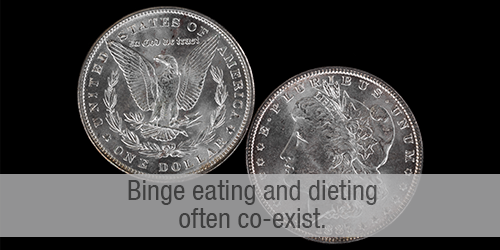In the US, 9% of the population will struggle with an eating disorder at some point in their lives. Binge Eating Disorder (BED) is the second most common eating disorder; in any given year, 0.96% of women and 0.26% of men have BED. While the diagnostic criteria for Binge Eating Disorder focus on the binge part of the cycle, many people don’t realize that binge eating and dieting are often two sides of the same coin.
BED and Dieting Often Co-Exist
Many people with BED describe cycles of binge eating followed by restrictive dieting. While it may seem that the decision to start another round of dieting is a result of binge eating, it may actually be the other way around.
Dietary restraint (as it is often referred to in the research) may lead to hunger, deprivation, cravings, and frequent thoughts of food. We’ve been talking about it for years, but this common and expected response to restriction has recently been rebranded by pharmaceutical companies as “food noise.”
Understandably, this “food noise” leads to eating, which causes guilt over breaking one’s diet. Once the diet has been broken, the dieter thinks, “I’ve already blown it. I might as well keep eating.”
This leads to uncomfortable fullness and more guilt, then back to dieting to make up for it. We refer to this as the eat-repent-repeat cycle.
Binge-Repent-Repeat Cycle
This process is greatly magnified in individuals who struggle with binge eating (the binge-repent-repeat cycle). While it’s difficult to definitively say whether dieting causes or contributes to binge eating in any particular person, they often go hand-in-hand. Nearly everyone I’ve worked with who struggles with binge eating describes restriction at some point in their eating disorder.
As described by Dr. Kari Anderson in this excerpt from our book, Eat What You Love, Love What You Eat for Binge Eating: A Mindful Eating Program for Healing Your Relationship with Food and Your Body:
When reality sets in after the binge, you may feel overcome with emotion and full of rage—wanting to throw, hit, or scream—or feel despondent, hopeless, or wishing you could die. The feelings of guilt and self-hatred lead to more negative self-talk and further isolation. This increases secrecy, shame, loneliness, and other emotions that perpetuate the cycle.
In the aftermath of a binge, there is usually a sense of desperation and a renewed dedication to the next diet. You make plans to be “good” again—the next day, “on Monday,” or “after the holidays.” Of course dieting doesn’t stop binge eating. For many people restrictive eating simply becomes part of the binge cycle.
Unfortunately, most people blame themselves when the diet fails and they binge again. The guilt and shame they experience feeds the cycle.
The good news is that effective treatment is available! If you struggle with emotional eating or binge eating, click here to learn more about the Am I Hungry? Mindful Eating for Binge Eating Program.
This article has been updated from a previously published version.
Enjoyed this article? Here are three more to help you:
Symptoms of Binge Eating Disorder
Self Help for Binge Eating Disorder (BED)

